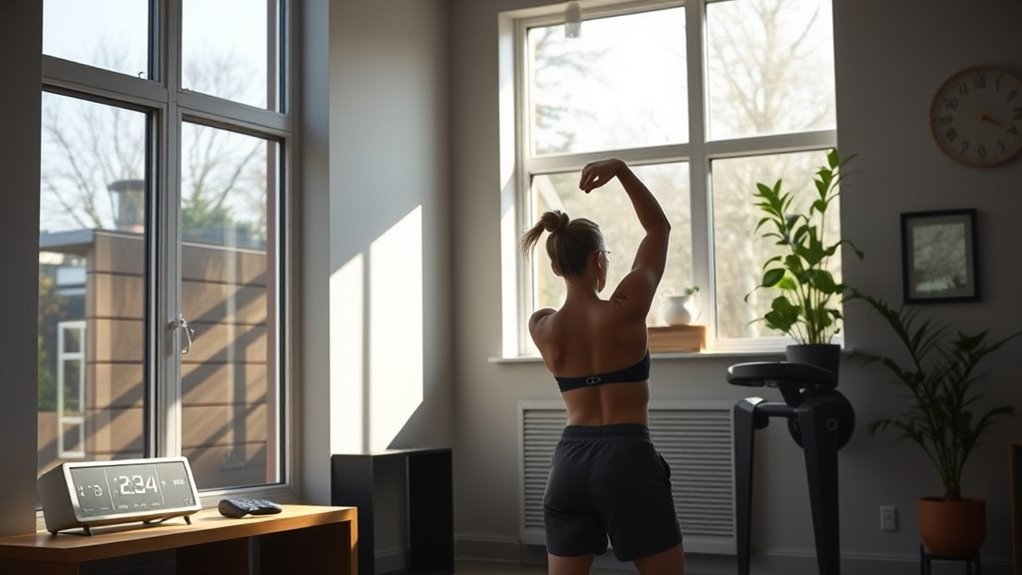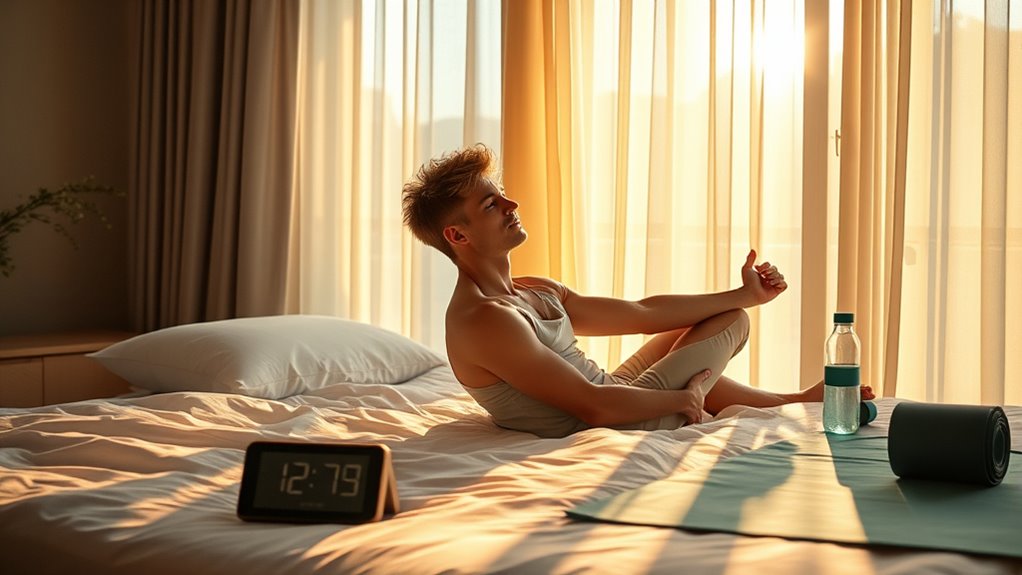Aligning your workouts with your natural body clock helps boost your performance, recovery, and motivation. By timing exercise during your peak alertness or metabolic periods, you optimize energy use and reduce fatigue. Morning people benefit from early workouts, while night owls perform best later in the day. When you sync fitness routines with your chronotype, it becomes easier to stay consistent and feel more energized. Keep exploring to discover how tailoring your schedule can maximize your results.
Key Takeaways
- Align workout times with your natural alertness peaks to improve performance and motivation.
- Morning people should exercise earlier; night owls benefit from late afternoon or evening sessions.
- Timing workouts during high metabolic periods enhances fat burning and muscle gain.
- Exercising at appropriate times supports better sleep quality and overall recovery.
- Synchronizing exercise with your chronotype promotes sustainable habits and long-term health benefits.

Your natural sleep-wake preferences, known as chronotypes, influence when you feel most alert and energized during the day. These internal clocks affect your sleep patterns, determining whether you’re naturally inclined to wake early or stay up late. Recognizing your chronotype can help you optimize workouts by timing them when your body is primed for activity. When you align your exercise routine with your internal clock, you’re more likely to experience better performance, quicker recovery, and increased motivation. For example, if you’re a morning person, exercising early might feel more natural and sustainable. Conversely, night owls may find their peak performance aligns with late afternoon or evening workouts.
Aligning workouts with your chronotype boosts performance, recovery, and motivation throughout the day.
Your chronotype also impacts your metabolic rates, which fluctuate throughout the day. During your most alert periods, your body tends to burn calories more efficiently, supporting energy expenditure during workouts. When you work out during these times, you leverage your body’s natural metabolic rhythms, making your exercise more effective. Conversely, exercising when your metabolic rate is lower—say, early morning if you’re a night owl—might not yield the same results. Understanding this relationship helps you plan workouts that maximize fat burning and muscle gain, tailored to your body’s innate patterns.
Timing your workouts to match your chronotype isn’t just about performance; it can also influence your sleep quality. Exercising at the right times can promote better sleep, especially if you work out during your body’s natural high-energy windows. For example, evening workouts might be ideal for night owls, helping them wind down and improve sleep quality, provided the exercise isn’t too close to bedtime. On the other hand, morning workouts can energize early risers and help establish a consistent sleep schedule, reinforcing their natural sleep patterns.
Moreover, syncing your exercise routine with your chronotype can reduce feelings of fatigue and burnout. When you push yourself during your body’s peak times, you’re less likely to overexert and more likely to recover efficiently. This harmony between your internal clock and physical activity can lead to more sustainable habits and long-term health benefits. Additionally, consistent exercise routines support your body’s circadian rhythms, further optimizing your overall health. Ultimately, understanding your chronotype empowers you to craft a workout schedule that respects your natural rhythms, making fitness feel less like a chore and more like a seamless part of your lifestyle. By listening to your body’s signals and timing your workouts accordingly, you optimize your energy, enhance your results, and support overall well-being.
Frequently Asked Questions
Can Chronotype Change Over Time?
Your chronotype can change over time due to age-related changes and lifestyle factors. While some people experience chronotype flexibility, meaning their sleep-wake preferences shift, others find their natural rhythms remain stable. As you age, your body’s circadian rhythm may adjust, making you more of a morning or evening person. Staying mindful of these changes helps you optimize your routines, ensuring you work with your body’s natural clock for better health and productivity.
How Do I Find My Natural Chronotype?
To find your natural chronotype, pay attention to your biological rhythms and sleep patterns. Notice when you naturally feel most alert and energetic, and when you tend to feel sleepy. Keep a sleep journal for a week, recording your sleep and wake times, energy levels, and alertness. This helps reveal whether you’re a morning person, night owl, or somewhere in between, so you can align your activities accordingly.
Is It Better to Workout Alone or With Others?
Deciding whether to workout alone or with others depends on your preferences and goals. Solo workouts let you focus intensely and set your own pace, which can boost motivation. Group exercise offers social support, accountability, and added energy, making workouts more enjoyable. You might prefer both at different times—use solo sessions for concentration and group classes for motivation. Choose what keeps you consistent and energized.
Do Different Chronotypes Prefer Different Exercise Types?
They say, “Know thyself,” and that’s key when it comes to exercise. Different chronotypes prefer different workout types and intensities, affecting workout timing and how you feel doing them. Morning larks might thrive with high-intensity workouts early, while night owls may perform better later in the day. Matching exercise intensity and timing to your body clock helps you stay motivated, energized, and consistent, making your fitness routine more effective.
Can Adjusting Workouts Improve Sleep Quality?
Adjusting your workouts can definitely improve sleep quality. By aligning exercise timing with your body’s natural rhythms, you’ll support better sleep hygiene, making it easier to fall asleep and stay asleep. For example, exercising too late might disrupt your sleep, while earlier workouts can promote relaxation and rest. Experimenting with workout timing helps you find what works best for your body, leading to more restorative sleep and overall well-being.
Conclusion
Understanding your chronotype can optimize your workout routine and boost your energy levels. Did you know that morning people tend to have higher metabolic rates early in the day, making morning workouts more effective for them? By syncing your exercise with your body’s natural rhythm, you not only improve performance but also enhance recovery. So, pay attention to your body’s clock—your best workout might just be when your body is most ready and alert.










